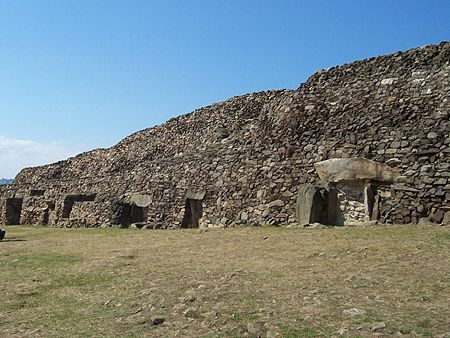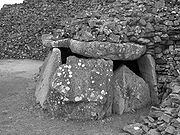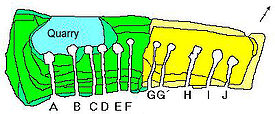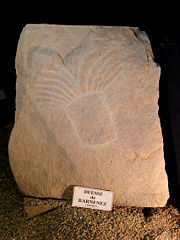
Barnenez
Encyclopedia

Neolithic
The Neolithic Age, Era, or Period, or New Stone Age, was a period in the development of human technology, beginning about 9500 BC in some parts of the Middle East, and later in other parts of the world. It is traditionally considered as the last part of the Stone Age...
monument located near Plouezoc'h, on the Kernéléhen peninsula in northern Finistère
Finistère
Finistère is a département of France, in the extreme west of Brittany.-History:The name Finistère derives from the Latin Finis Terræ, meaning end of the earth, and may be compared with Land's End on the opposite side of the English Channel...
, Brittany
Brittany
Brittany is a cultural and administrative region in the north-west of France. Previously a kingdom and then a duchy, Brittany was united to the Kingdom of France in 1532 as a province. Brittany has also been referred to as Less, Lesser or Little Britain...
(France
France
The French Republic , The French Republic , The French Republic , (commonly known as France , is a unitary semi-presidential republic in Western Europe with several overseas territories and islands located on other continents and in the Indian, Pacific, and Atlantic oceans. Metropolitan France...
). It dates to the early Neolithic
Neolithic
The Neolithic Age, Era, or Period, or New Stone Age, was a period in the development of human technology, beginning about 9500 BC in some parts of the Middle East, and later in other parts of the world. It is traditionally considered as the last part of the Stone Age...
, about 4500 BC; it is considered one of the earliest megalithic monuments in Europe
Europe
Europe is, by convention, one of the world's seven continents. Comprising the westernmost peninsula of Eurasia, Europe is generally 'divided' from Asia to its east by the watershed divides of the Ural and Caucasus Mountains, the Ural River, the Caspian and Black Seas, and the waterways connecting...
. It is also remarkable for the presence of megalithic art
Megalithic art
Megalithic art refers to the use of large stones as an artistic medium. Although some modern artists and sculptors make use of large stones in their work, the term is more generally used to describe art carved onto megaliths in prehistoric Europe....
.
History

Dates
RadiocarbonRadiocarbon dating
Radiocarbon dating is a radiometric dating method that uses the naturally occurring radioisotope carbon-14 to estimate the age of carbon-bearing materials up to about 58,000 to 62,000 years. Raw, i.e. uncalibrated, radiocarbon ages are usually reported in radiocarbon years "Before Present" ,...
dates indicate that the first phase of the monument was erected between 4850 and 4250 BC, and the second phase between 4450 and 4000 BC.
Secondary use
Pottery found in and around the monument indicates that it underwent a period of reuse in the Bronze AgeBronze Age
The Bronze Age is a period characterized by the use of copper and its alloy bronze as the chief hard materials in the manufacture of some implements and weapons. Chronologically, it stands between the Stone Age and Iron Age...
, in the 3rd millennium BC.
Recognition as an ancient monument
The cairn was first mapped in 1807, in the context of the Napoleonic cadaster. Its first scientific recognition took place in the context of an academic congress in Morlaix in 1850, when it was classified as a tumulusTumulus
A tumulus is a mound of earth and stones raised over a grave or graves. Tumuli are also known as barrows, burial mounds, Hügelgrab or kurgans, and can be found throughout much of the world. A tumulus composed largely or entirely of stones is usually referred to as a cairn...
.
Quarry damage
Privately owned until the 1950s, the cairn was used as a quarryQuarry
A quarry is a type of open-pit mine from which rock or minerals are extracted. Quarries are generally used for extracting building materials, such as dimension stone, construction aggregate, riprap, sand, and gravel. They are often collocated with concrete and asphalt plants due to the requirement...
for paving stones. This activity, which threatened to destroy the monument, was only halted after the discovery of several of its chambers in the 1950s. The local community then took control of the site.
Restoration and excavation
The cairn was restored between 1954 and 1968. At the same time, vegetation was removed from the mound and systematic excavation took place in and around the monument.The mound
Today, the Barnenez cairn is 72 m long, up to 25 m wide and over 8 m high. It is built of 13,000 to 14,000 tons of stone. It contains 11 chambers entered by separate passages. The mound has steep facades and a stepped profile. Several internal walls either represent earlier facades or served the stability of the structure. The cairn consists of relatively small blocks of stone, with only the chambers being truly megalithic in character.The monument overlooks the Bay of Morlaix
Morlaix
Morlaix is a commune in the Finistère department of Brittany in northwestern France. It is a sub-prefecture of the department.-Leisure and tourism:...
, probably a fertile coastal plain at the time of its erection.

Cairn 1, before 4,500 BC
In a first phase, a slightly trapezoidal mound of 32 m by 9 to 13 m was erected. It contained 5 chambers and was surrounded by a double kerb. The first phase favoured the use of dolerite.Cairn 2, circa 4,200 - 3,900 BC (?)
In a second phase, an extension with six further chambers was added in the west. At the same time, Cairn 1 was enveloped in a wider and taller structure; its passages had to be extended. More graniteGranite
Granite is a common and widely occurring type of intrusive, felsic, igneous rock. Granite usually has a medium- to coarse-grained texture. Occasionally some individual crystals are larger than the groundmass, in which case the texture is known as porphyritic. A granitic rock with a porphyritic...
was used in this phase.
The chambers
The 11 chambers of the Barnenez cairn are of the type known as DolmenDolmen
A dolmen—also known as a portal tomb, portal grave, dolmain , cromlech , anta , Hünengrab/Hünenbett , Adamra , Ispun , Hunebed , dös , goindol or quoit—is a type of single-chamber megalithic tomb, usually consisting of...
à couloir in French archaeological terminology. The term translates roughly as "passage grave
Passage grave
thumb|250px|right|A simple passage tomb in [[Carrowmore]] near [[Sligo]] in IrelandA passage grave or passage tomb consists of a narrow passage made of large stones and one or multiple burial chambers covered in earth or stone. Megaliths are usually used in the construction of passage tombs, which...
". They are built of large slabs of slate
Slate
Slate is a fine-grained, foliated, homogeneous metamorphic rock derived from an original shale-type sedimentary rock composed of clay or volcanic ash through low-grade regional metamorphism. The result is a foliated rock in which the foliation may not correspond to the original sedimentary layering...
and granite
Granite
Granite is a common and widely occurring type of intrusive, felsic, igneous rock. Granite usually has a medium- to coarse-grained texture. Occasionally some individual crystals are larger than the groundmass, in which case the texture is known as porphyritic. A granitic rock with a porphyritic...
. Originally, all the chambers were entirely enclosed by the mound. The fact that several of them are partially exposed now is the result of modern quarrying.
Each of the 11 chambers is reached from the southeast via a long narrow passage (7–12 m long). They are arranged parallel to each other. Shapes and construction techniques differ slightly.
In nine cases, narrow passages lead to corbelled chambers. Normally, the corbel vault rests on orthostats, in one chamber it actually sits on the ground, forming a true tholos
Tholos
Τholos is the name given to several Ancient Greek structures and buildings:**The Tholos at Athens was the building which housed the Prytaneion, or seat of government, in ancient Athens...
. The passages have slab-built or dry stone walls and are covered with slabs. One of the chambers has a dry-stone vaulted ante-chamber.

Logistics
One cubic metre of the Barnenez cairn contains 1,500 kg of stone. It is estimated that the quarrying, fashioning, transport and construction of such an amount represents about four work days for a single worker (assuming a 10-hour day). The original monument, Cairn 1, had a volume of about 2,000 cubic metres; it is built of 1,000 tons of granite and 3,000 tons of dolerite. It would thus have required 15,000 to 20,000 working days; in other words, it would have taken 200 workers three months to erect Cairn 1 alone. In its final form, the Barnenez mound is nearly three times as big as the first phase.
Engraved symbols
Engraved symbols occur in several of the chambers and passages. They depict bows, axes, wave symbols or snakes and a repeated U-shaped sign. One of the carved slabs is in secondary use was originally part of a different structure, an interesting parallel to the situation in several other such monuments, including GavrinisGavrinis
Gavrinis is a small island, situated in the Gulf of Morbihan in Brittany, France. It contains the Gavrinis tomb, a megalithic monument notable for its abundance of megalithic art in the European Neolithic. Administratively, it is part of the commune of Larmor-Baden.-Geography:Reachable by boat...
.
The symbols on the engraved blocks resemble those found in other megalithic monuments in Brittany; in broader terms they belong to the cultural phenomenon described as megalithic art
Megalithic art
Megalithic art refers to the use of large stones as an artistic medium. Although some modern artists and sculptors make use of large stones in their work, the term is more generally used to describe art carved onto megaliths in prehistoric Europe....
. One of the recurring symbols is sometimes interpreted as an anthropomorphic depiction (the so-called "Dolmen Goddess").
Material from the original period of use
Only Cairn 2, namely chambers A, C and D, contained NeolithicNeolithic
The Neolithic Age, Era, or Period, or New Stone Age, was a period in the development of human technology, beginning about 9500 BC in some parts of the Middle East, and later in other parts of the world. It is traditionally considered as the last part of the Stone Age...
finds at the time of excavation. They included pottery, polished stone axes (of dolerite), flint
Flint
Flint is a hard, sedimentary cryptocrystalline form of the mineral quartz, categorized as a variety of chert. It occurs chiefly as nodules and masses in sedimentary rocks, such as chalks and limestones. Inside the nodule, flint is usually dark grey, black, green, white, or brown in colour, and...
blades and arrowheads.
Bronze Age pottery
Pottery sherds found outside the monument indicate that it was reused in the Bronze AgeBronze Age
The Bronze Age is a period characterized by the use of copper and its alloy bronze as the chief hard materials in the manufacture of some implements and weapons. Chronologically, it stands between the Stone Age and Iron Age...
(3rd millennium BC). A copper dagger and a barbed arrowhead are of Chalcolithic date.
Comparable monuments
Similar, possibly contemporary, monuments are known at 22 other locations in France and on JerseyJersey
Jersey, officially the Bailiwick of Jersey is a British Crown Dependency off the coast of Normandy, France. As well as the island of Jersey itself, the bailiwick includes two groups of small islands that are no longer permanently inhabited, the Minquiers and Écréhous, and the Pierres de Lecq and...
. Breton examples are Larcuste-Colpo, Le Bono, Petit Mont, Ty-Floc´h, Gavrinis
Gavrinis
Gavrinis is a small island, situated in the Gulf of Morbihan in Brittany, France. It contains the Gavrinis tomb, a megalithic monument notable for its abundance of megalithic art in the European Neolithic. Administratively, it is part of the commune of Larmor-Baden.-Geography:Reachable by boat...
, Île Carn, Ploudalmézeau and Guennoc (I´ile Gaignoc -
sometimes spelt Guénioc) off the shore at Landéda
Landéda
Landéda is a commune in the Finistère department of Brittany in north-western France.-Geography:The coastal commune of Landéda forms a peninsula between two rias, the Aber Wrac'h to the north and the Aber-Benoît to the south.-History:...
. Those located on islands are generally better preserved. Chamber 3 B at Guennoc contains a small standing stone
Standing stone
Standing stones, orthostats, liths, or more commonly megaliths are solitary stones set vertically in the ground and come in many different varieties....
near the entrance.

